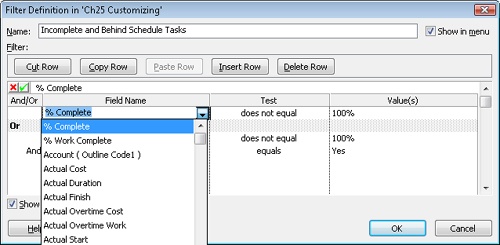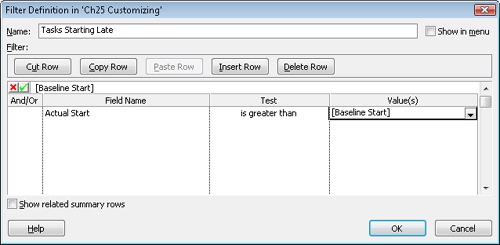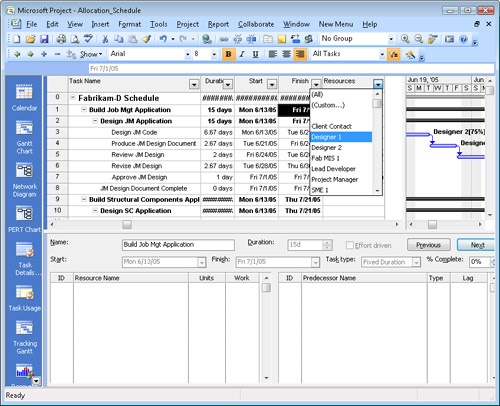Projects contain so much information that data that isn’t pertinent can simply get in the way. Filters restrict the tasks or resources that appear so that you can more easily analyze a situation. Microsoft Project provides a number of standard filters that you can use as-is to hide certain kinds of information you don’t need to see in a given situation. For example, the Incomplete Tasks filter displays only those tasks that are either in progress or not yet started so that you can focus on work yet to be done. These filters work equally well as templates for your own customized filters. You can create a filter based on the Incomplete Tasks filter to display incomplete tasks that are behind schedule. This enables you to see what kind of course correction you need.
Note
For more information about working with the built-in Microsoft Project filters, see the section titled Filtering Project Information in Chapter 4.
You can modify an existing filter, but it’s better to keep the original filter intact by copying the filter and then modifying the copy. To customize a filter, follow these steps:
Click Project, Filtered For, More Filters.
In the More Filters dialog box, select the Task or Resource option to display the task or resource filters.
Click the filter you want to modify and then click Edit or Copy.
In the Name box, change the name to indicate what the filter shows.
Click the Field Name cell you want to change, click the down arrow, and then click the name of the field by which you want to filter (see Figure 25-23).
Click the Test cell, click the down arrow, and then click the name of the test you want to use for the filter.
In the Value(s) cell, specify the value you want to use for the filter test. You can type a value, click a field name from the list, or type a prompt to define an interactive filter.
Note
For information about creating an interactive filter, see the section titled Creating Interactive Filters later in this chapter.
To display the summary tasks for tasks that pass the filter criteria, select the Show Related Summary Rows check box.
Table 25-1 describes the tests you can use within a filter and provides an example of each.
Table 25-1. Filters
Filter test | How you can use it |
|---|---|
Equals | The values must be equal. For example, to filter for milestones, test whether the Milestone field equals Yes. |
Does Not Equal | The values are different. For example, to show tasks with overtime, test whether the Overtime Work field does not equal 0. |
Is Greater Than | The value in the field is greater than the entry in the Value(s) cell. For example, to show tasks that are late, test for the Finish field greater than the Baseline Finish field. |
Is Greater Than Or Equal To | The field value is greater than or equal to the entry in the Value(s) cell. For example, to show tasks at least 50 percent complete, test whether the % Complete field is greater than or equal to 50 percent. |
Is Less Than | The field value is less than the entry in the Value(s) cell. For example, to show tasks that are ahead of schedule, test for the Finish field less than the Baseline Finish field. |
Is Less Than Or Equal To | The field value is less than or equal to the entry in the Value(s) cell. For example, to show tasks that are within budget, test whether the Cost Variance field is less than or equal to 0. |
Is Within | The Field Name value is between or equal to the boundary values in the Value(s) cell. For example, to find the tasks within a range, test whether the ID is within the range specified in the Value(s) cell. To specify a range, type the starting value, type a comma, and then type the last value, such as 100,200. |
Is Not Within | The Field Name value is outside the boundary values in the Value(s) cell. For example, to find the tasks that are not in progress, test whether the % Complete value is not within 1%–99%. |
Contains | The field value is text that contains the string in the Value(s) cell. For example, to find the tasks to which resources from any development group are assigned, test whether the Resource Group field contains the word Development. |
Does Not Contain | The field value is text that does not contain the string in the Value(s) cell. For example, to find resources not in a resource group, check whether the Resource Group does not contain the name. |
Contains Exactly | The field value is text that must exactly match the string in the Value(s) cell. For example, to find tasks to which only a particular resource is assigned, check whether the Resource Name field contains exactly the resource’s name. |
Note
When you use the Equals or Does Not Equal test, you can compare a text field value to a string with wildcard characters. Wildcard characters include the following:
* represents one or more characters.
? represents any single character.
For example, DB* matches DB Developer, DB Administrator, and DB Designer. Des??? matches Design, but does not match Describe.
If you can’t find a filter similar to what you want, you can create one and filter on any field or combination of fields in Microsoft Project, including custom fields that you defined. To create a new filter, follow these steps:
Click Project, Filtered For, More Filters.
In the More Filters dialog box, select the Task or Resource option to create a task or resource filter and then click New.
In the Filter Definition dialog box, type a descriptive name for the filter in the Name box.
If you want the new filter to appear on the Filtered For menu, select the Show In Menu check box.
Enter the field, test, and values that define your filter criteria.
To include the summary rows for the tasks or resources that meet the filter criteria, select the Show Related Summary Rows check box.
Some of the handiest filters use criteria that compare the values in two different fields for the same task or resource. For example, to look for tasks that haven’t started according to plan, you can filter for tasks in which the Actual Start date is greater than the Baseline Start date.
To define a test that compares two fields, do the following:
In the Filter Definition dialog box, click the Field Name cell, click the down arrow, and then click the name of the field by which you want to filter, for example, Actual Start.
Click the Test cell, click the down arrow, and then click the name of the test you want to use, "is greater than" in this example.
Click the Value(s) cell, click the down arrow, and then click the name of the field with which you want to compare the first field (see Figure 25-24)—in this example, [Baseline Start].
A field name in the Value(s) cell is enclosed in square brackets [ ].
Sometimes it takes more than one or two criteria to filter the list to your satisfaction. You can create filters in which tasks or resources must meet at least one of the criteria or all of the criteria.
To define multiple filter criteria, follow these steps:
In the Filter Definition dialog box, in the Name box, type a descriptive name for the filter.
In the first row in the table, specify the field, test, and value for the first set of filter criteria.
In the second row, click the And/Or cell in the second row and then click And or Or.
If you click And, the resulting filter displays only elements that meet both criteria. The filter displays tasks that meet one or both of the criteria when you click Or.
In the second row, specify the field, test, and values for the second set of filter criteria.
Repeat steps 2–4 for any additional tests you want to define for the filter, defining each test on a separate row in the table and relating them with an And or Or.
With more than one test, filters evaluate tests in the order in which they occur in the filter definition. The filter restricts elements to those that pass the first test and then compares those results to the outcome of the next test. The filter continues until there are no further tests to evaluate.
In some cases, you might want to adjust the order in which the tests are evaluated. For example, you might want to filter tasks first for those that use a particular resource and that aren’t yet complete. Then you want to further filter the list for tasks that start and finish within a particular date range. You can control the order that Microsoft Project evaluates tests by clicking And or Or in the And/Or cell of an otherwise empty row. Including a test in an empty row is the equivalent of placing parentheses around the tests that occur before and after the empty row.
Do the following to group criteria within a filter:
Define one or more tests for the first group of filter criteria.
In the next blank row after the first group of criteria, click the And/Or cell and then click And or Or. Keep the rest of this row blank.
This blank row containing only And or Or creates the grouping between the first set of filter criteria and the second set.
In the next row, define the tests for one or more additional filter criteria (see Figure 25-25).
In many cases, you want to supply different values each time you apply a filter. Interactive filters request values and then filter based on the values you provide.
To create an interactive filter, follow these steps:
In the Filter Definition dialog box for a new filter, in the Name box, type a descriptive name for the filter.
Click the field and test for the filter.
In the Value(s) cell, type a text string within quotation marks followed by a question mark (see Figure 25-25).
When you apply your new interactive filter, the text string you entered appears as a prompt in a dialog box (see Figure 25-26). The question mark instructs Microsoft Project to pause until the user enters the value.
AutoFilter is an easy way to filter by values in a single field, for example, to show tasks assigned to a specific resource. In addition, you can quickly create custom filters by saving an AutoFilter test.
To use AutoFilter to create a custom filter:
Display the sheet view whose rows you want to filter.
Click AutoFilter on the Formatting toolbar.
The AutoFilter arrows appear in the column headings for each field in the sheet view (see Figure 25-27).
Click the arrow in the column whose information you want to filter by and then click Custom.
The Custom AutoFilter dialog box appears with the field set to the current column.
Click the arrow in the first test box and then click the criteria you want to apply.
In the first value box, click the arrow and then enter a value or field name.
To add a second test, select the And or Or option.
Click the test and value for the second test (see Figure 25-28).
To save the AutoFilter test, click Save.
The Filter Definition dialog box appears with the tests that you defined via AutoFilter. You can enter a filter name and make other changes before you click OK to save the filter.






